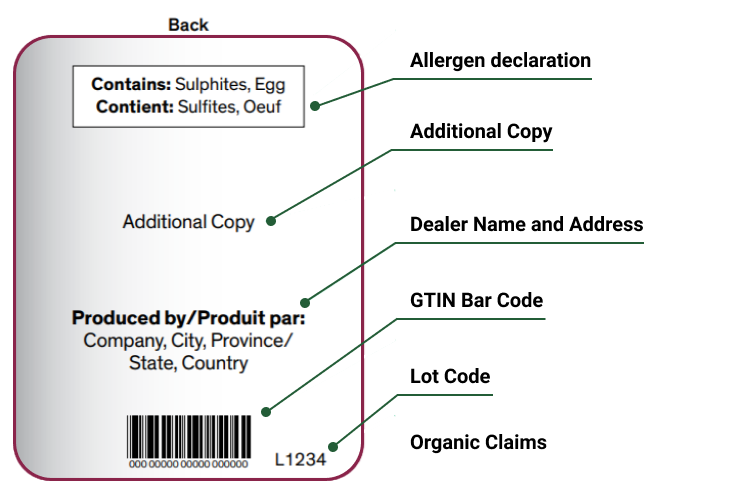For products that meet the Standard of Identity for wine as per the Food & Drug Regulations Division 2
Front

Vignette and product brand name are optional but must not be misleading or imply irresponsible use of product when used.
Common Name / The common name declaration must be bilingual. Names of varietals are not acceptable as common names. It is permissible to use an adjective (e.g. red wine/vin rouge). Minimum height 1.6 mm based on the lower case “o”.
Country of Origin / A bilingual country of origin declaration is required, minimum height 1.6 mm. Note: Wines produced in Canada from imported grapes or juice cannot be declared as Canadian. See Product Specific Information for Wine on the CFIA website for acceptable declarations.
Net Quantity / The minimum size of numerical characters varies with surface area of container. The minimum size for a 750 mL or 1.5L bottle is 3.2 mm. See the Safe Foods for Canadians Regulations, Schedule 6 for other container sizes. Volumes under 1 litre must be in mL. Volumes one litre and over must be in litres (L). Minimum size of mL or L is 1.6 mm, based on the lower case “m”.
Alcohol Strength / This is the bilingual format for alcohol declaration. The smallest letter must be at least 1.6 mm in height. “alc. X.X% vol.” is also accepted as bilingual.
Single Field of Vision / Common name, net quantity, alcohol strength and country of origin must be visible in a single field of vision (not split between the front and back labels). These mandatory items can either be together on the back or front label.
Back

Allergen declaration / An allergen declaration is required for wines (unless no allergenic ingredients used). Most common allergen in wine is added sulphites. Declaration of an allergenic fining agent (e.g. fish (isinglass), egg (albumen), milk (casein)) is required if the wine contains residues of the agents (i.e. not finely filtered). Flavoured wines and vermouths may have other allergenic ingredients which would require declaration in this statement. The declaration must appear in a box and be black text on a white background. Minimum font height of 1.1mm lower case “o”.
Additional Copy /Any copy or statements must not be misleading or imply irresponsible use of product. Not required to be bilingual.
Dealer Name and Address / Require name and address of manufacturer or Canadian importer. Importer info must be preceded with “imported for / importé pour”. (American importer must be removed or preceded with “In USA imported by”.) Must be minimum 1.6 mm in height based on the lower case “o”. Country name must be in English or French.
GTIN Bar Code must appear on all consumer selling units. Minimum 80% magnification required. Human readable characters should be on the left (if vertical placement) and on the bottom (if horizontal placement).
Lot Code / All selling units must bear a lot code. A lot code can be numeric, alphabetical or alphanumeric and must be readily discernable and legible.
Organic Claims / The label of an organic product must have a bilingual organic claim ‘organic/ biologique’ and bear the name of the certification body that has certified the product as organic under part 13 of the SFCR
Product Code Marking & Refund Statements / As per the Safe Food for Canadians Regulations (SFCR) a lot code is required on all selling units (mandatory since July 2020). A product date code is required on bag-in-a-box and TetraPak formats. Refund statements are optional but, if present, must be bilingual, minimum 1.6 mm in height. They must be worded such that the purchaser cannot construe that the point of return is the LCBO (e.g. contain a disclaimer such as “where applicable”).
________
Published November 2020, updated to align with the CFIA’s Food Modernization Initiative and the Safe Food for Canadians Act & Regulations. In producing these simplified guidelines, some requirements may not have been included and some may be ambiguous. The LCBO takes no responsibility for any problems / errors in label design resulting from using these guidelines.
It is the supplier responsibility to ensure that a product label complies with all applicable Canadian laws, Canadian Association of Liquor Jurisdictions (CALJ) standards, and LCBO Product Packaging Standards and other LCBO operational and policy requirements
